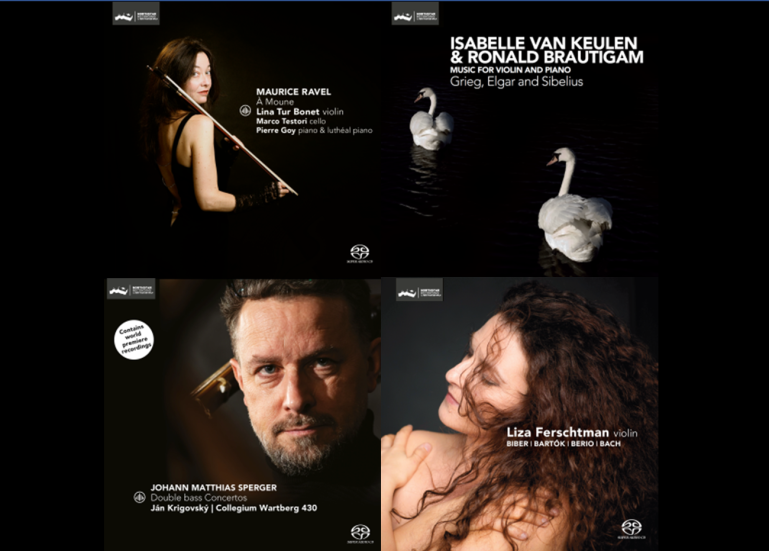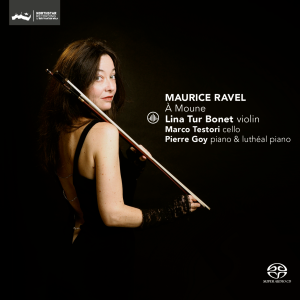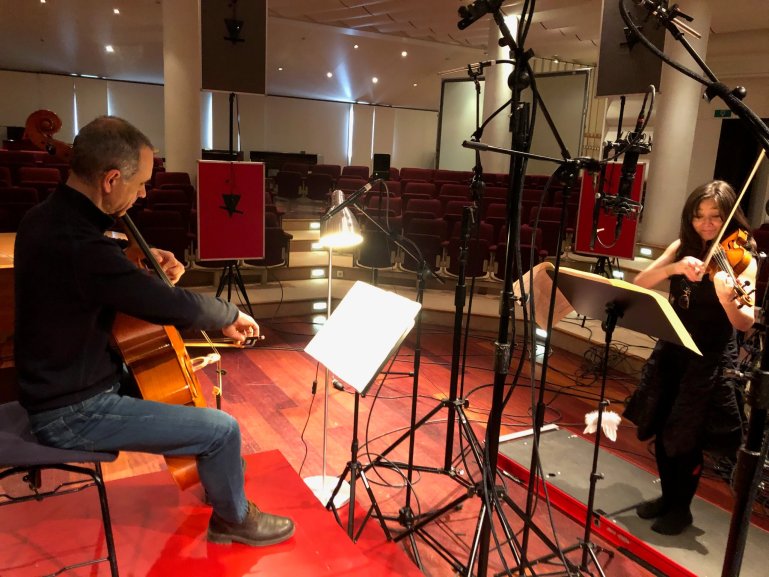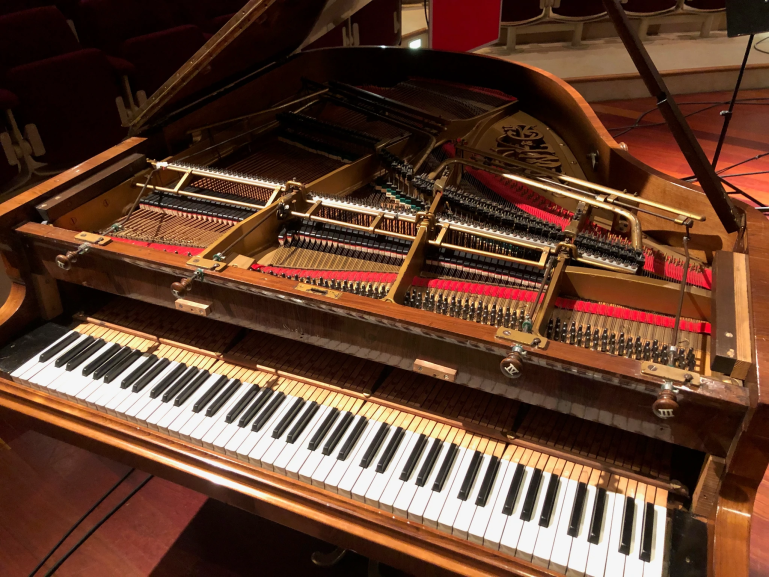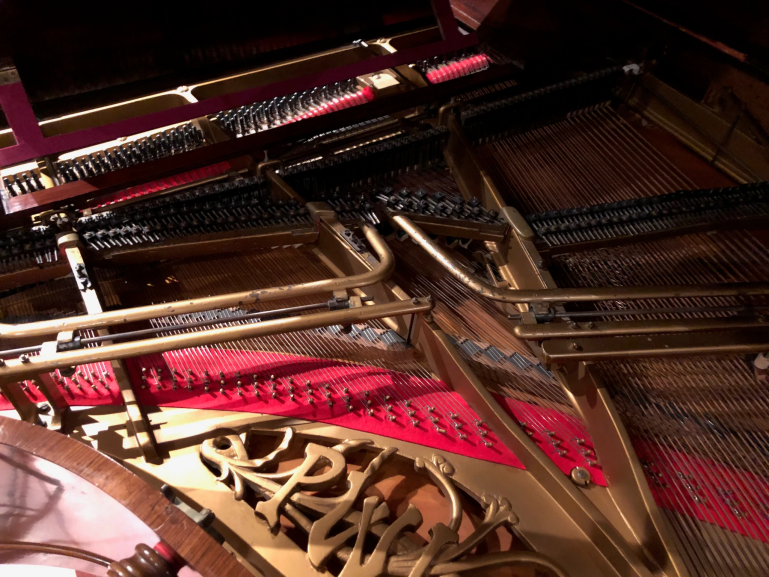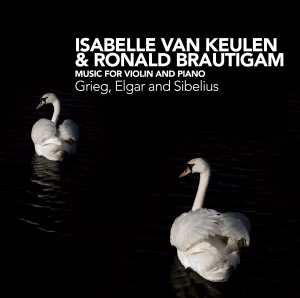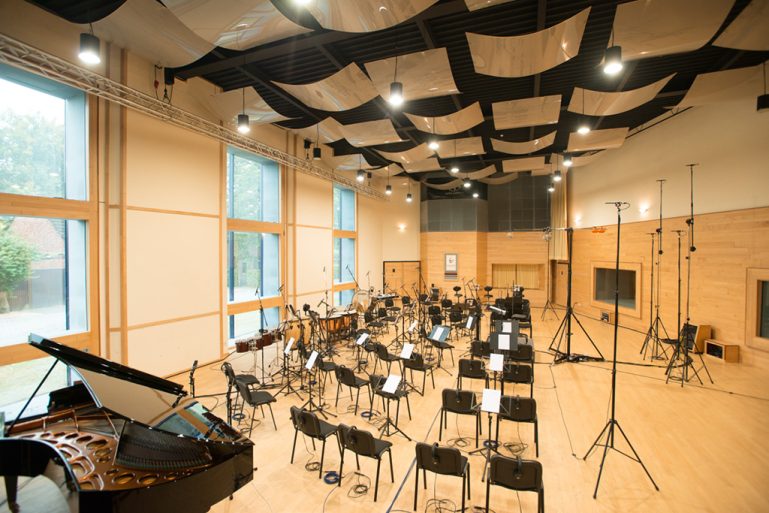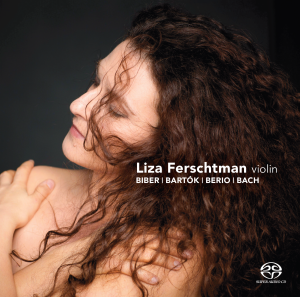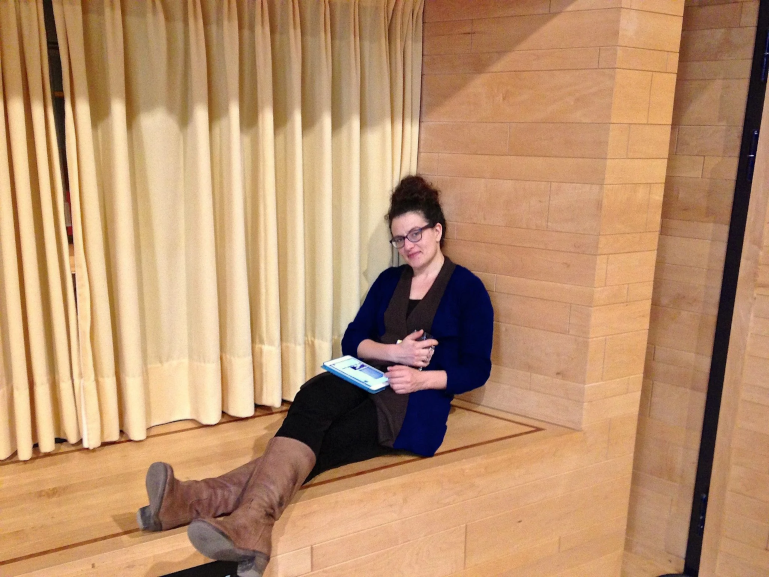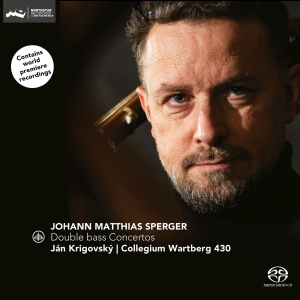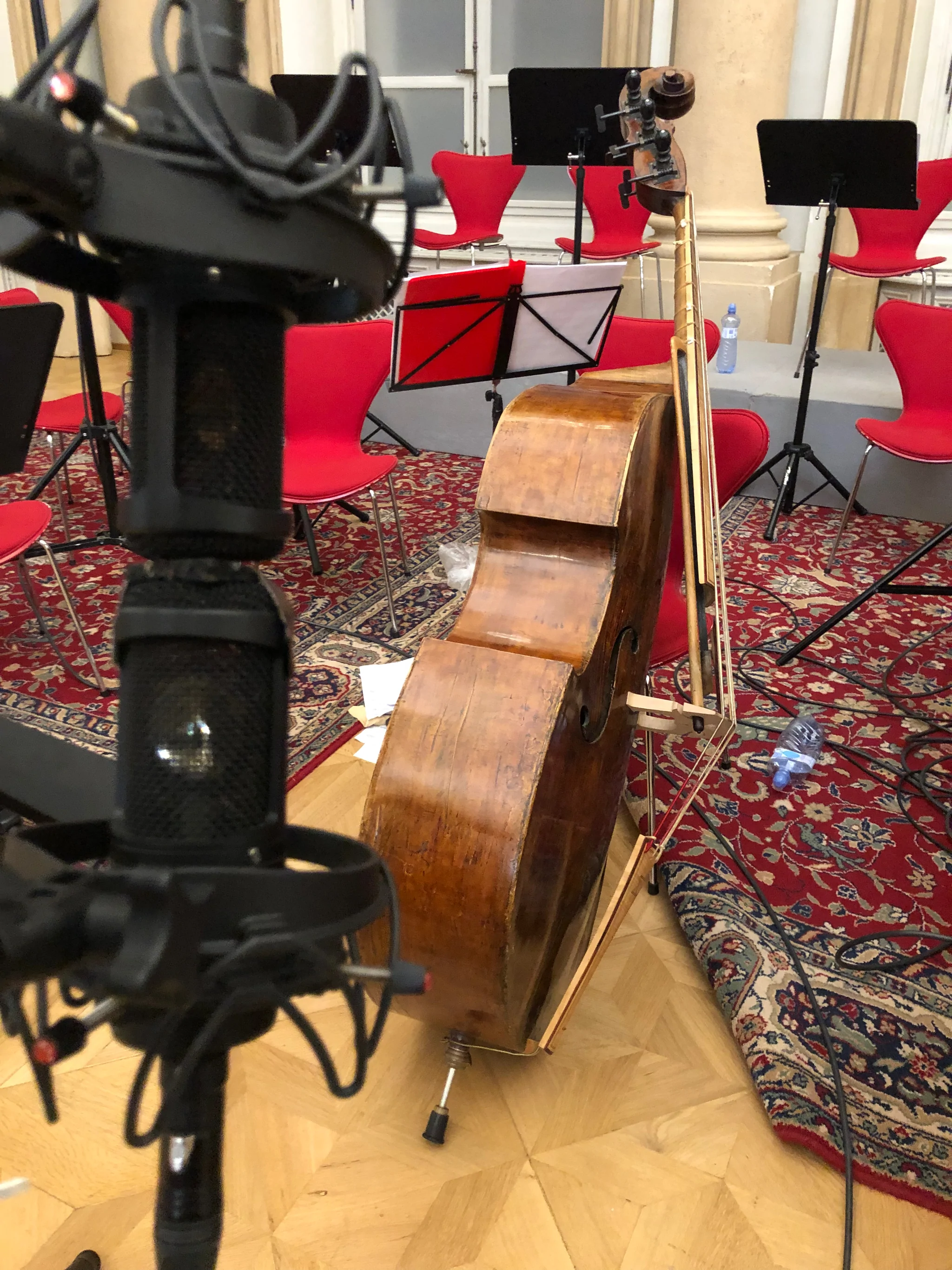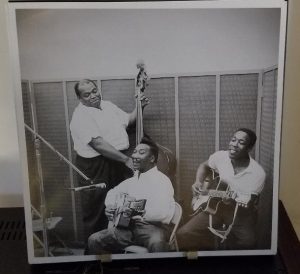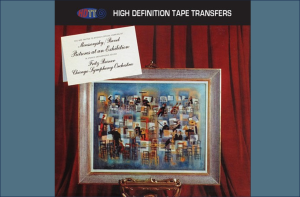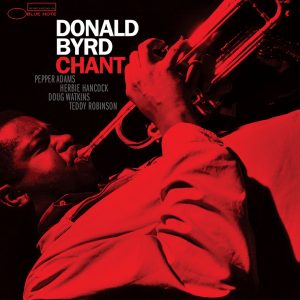Bert van der Wolf is one of the best recording engineers in the business today. His recordings have only gotten better and better over the years as he's been able to incorporate into his recording chain the latest developments in high end technology. I've written many times in these pages about various of his recordings that I treasure. His releases are always of the highest musical value (with excellent artists and interesting repertoire) along with the highest sonic standards. My feeling is "If Bert recorded it, I want to hear it." I've yet to be disappointed.
Here I am bringing together several album reviews in one article simply to get more information about his recordings to you, the reader. All of these are superb. Each is worthy of a dedicated article. Explore and enjoy.
- Ravel: À Moune - Lina Tur Bonet (violin), Marco Testori (cello), Pierre Goy (piano, luthéal)
- Grieg, Elgar and Sibelius for violin & piano - Isabelle van Keulen & Ronald Brautigam
- Music for Violin by Biber, Bartok, Berio, and Bach - Liza Ferschtman
- Johann Matthias Sperger: Double-bass Concertos - Ján Krigovský, Collegium Wartberg 430
- An interview with Bert van der Wolf, re-posted from the NativeDSD blog, with permission
Ravel: À Moune, Lina Tur Bonet (violin), Marco Testori (cello), Pierre Goy (piano, luthéal). Challenge Classics | Northstar, 2022 (DXD) HERE
- Ravel: Berceuse
- Ravel: Sonata for Violin and Piano
- Ravel: Tzigane
- Ravel: Sonata for Violin and Cello
Maurice Ravel had a close and enduring friendship with violinist Hélène Jourdan Mourhange, whom he affectionately called "Moune." The close friendship between the two lasted throughout his life and he often asked her for advice while composing his violin works. This album is a tribute by Lina Tur Bonet to Mourhange ("Moune") with performances of four works that Ravel wrote for her.
Of great interest for me is Bonet's election to use gut strings for violin and cello, as was customary at the time Ravel wrote these pieces. Also of interest, and not often heard, is Ravel's version of Tzigane written for a very unusual historical piano called a "luthéal piano." The luthéal piano is a prepared piano with registers of a harpsichord and a cymbal-like sound, and today is very rare (see photo below). It provides a wonderful gypsy-like flavor that nicely suits Tzigane, making this a very unusual performance.
For Bonet, this program is very special. She writes, "Hélène Jourdan Mourhange met Ravel for the first time after a concert in which she performed his Trio. She was an interesting, intelligent woman, well versed in the arts and culture of her time, and was a talented violinist who, however, had to stop playing years later due to rheumatoid arthritis. She then dedicated herself to musicology, reviews and other artistic activities. Not only that she was, like me, a violin player, but also shared that same disease, which I suffered in my youth. This has made me feel even closer to Ravel, and to feel a desire to make a tribute to Hélène by recording all the pieces written for her and thanks to her."
As to her choice to use gut strings, special bows of that period, and a historical piano, as well as the less known version of the Tzigane with the Luthéal, Bonet further explains, "The blending of gut strings between violin and cello, as well as with the old piano and the Luthéal is unique and helps to understand many of the aspects of performance in many old recordings."
All of this certainly makes this one of the more interesting recordings for violin and piano or cello, that I've heard this past year. And Bonet and her partners do not disappoint in their very engaging and delightful musicianship across the four works on this album.
Ravel's Berceuse, written for Moune, opens the album, and makes a very nice, gentle, and nuanced introduction for what will follow. The gut strings of Bonet's violin make a soft sound that gives this performance a distinctly different feel than is heard when played with modern steel strings.
The Sonata for Violin and Piano (1923-27), which Ravel dedicated to Moune, apparently took him many years to complete. The second movement, "Blues," was significant factor for Ravel to decide how to get this sonata just right. And Bonet hits it point-on, just a delightfully idiomatic performance that captures the syncopated rhythms and juxtapositions very nicely. Pierre Goy on piano delivers perfect partnership—far more than a mere accompaniment, his is a true equal contribution that makes the entire piece simply flow. This s nice a bit of jazz playing for violin and piano as you will hear. When Bonet effortlessly slides in the the final "Perpetuum mobile" movement, we know all is right in this world of Ravel. Her performance is confidently assured, propulsive, articulate. A great final movement for this sonata!
The fifth track is the always engaging Tzigane, here made even more intriguing by the use of the luthéal piano. The first four minutes is solo violin, with the gut strings of Bonet's instrument creating a harmonically rich, resonant sound with her excellent control and virtuosic playing. At 4:29' the luthéal piano enters. And, wow, what a scrumptious delight the unique sound of this instrument delivers. Between the two performers, one is about ready to join the gypsy dance. This one movement is worth the investment in this album. But there is so much more, also.
The final work is the roughly 20' Sonata for Violin and Cello (1921) that Ravel dedicated to Debussy and that Moune premiered. It was to be a first performance, Bonet writes, "that seems not to have been very well understood by the public. Ravel, who was unable to attend the premiere but read about it in a review, wrote to Hélène amusingly how performers seemingly 'slaughter' his work, accepting how difficult this coveted piece was for listeners in those days. Hélène recounts how difficult the preparation was, complaining to Ravel that he wanted the cello to 'sound like a violin', and the violin to 'sound like a drum'. Actually is one of Ravel’s bravest compositions." Heard with later 21st century ears, this work is complex and thoroughly engaging. It is a work best undertaken only by two equally skilled partners on cello and violin. And this is a totally gobsmacking performance with which to end this album.
When I first listened to this, I emailed Bert to tell him how much I enjoyed this recording. He replied, "This production is very dear to me as it was a long process of years, where Lina and I had this dream/vision of doing Ravel’s music on period instruments. Be sure to read about her connection with the repertoire and the story of Hélène Jourdan Mourhange in the booklet… Finding the proper instruments and dates in the schedules of all involved was a challenge. Lina’s schedule is killing as she is literally involved in 100’s of projects, ensembles and solo work, concert master with Jordi Savall as well these days…she's an incredibly talented musician!
"It worked out great due to our persistence and heartfelt wish to work on our first project together. Time restrictions and the COVID-19 pandemic prevented the Ravel Trio to be added as well, which is a shame. But, nevertheless, the result is mesmerizing in my perception and I feel humbled to have set this up with such a brilliant violinist."
As you may imagine, Highly Recommended!
From the recording session, Lina Tur Bonet (violin) and Marco Testori (cello).
Luthéal Piano (from the liner notes): The second instrument used for this recording, the piano/luthéal, is an instrument made in 1910 by the Parisian firm Pleyel, to which the luthéal mechanism has been fitted. The piano has a seven-octave compass, AAA-a4 and Pleyel’s double-escapement action. The luthéal was invented by Georges Cloetens (b. Brussels 1870, d. Brussels 1949). It can be installed in any normal grand piano and consists of various metal components that allow the pianist to modify the sound of the instrument through four registers, two working on the strings of bass half and two on the treble. In this way, the piano can be made to imitate the sound of a harpsichord, a harp or a lute, and, by combining these, the sound of a cymbalom.
Grieg, Elgar and Sibelius, music for violin & piano, Isabelle van Keulen & Ronald Brautigam. Challenge Classics | NorthStar, 2007 (DXD) HERE
- Grieg: Sonata for violin and piano no. 1 in F major, op. 8 (1865)
- Elgar: Sospiri op. 70 (1914)
- Sibelius: Sonata for violin and piano in E minor, op. 82 (1918)
"High-powered playing from Isabelle van Keulen and Ronald Brautigam, flawless in its technical accomplishment and brimful of big-boned vigour and assertiveness." - Gramophone, 2008
Yes, it is all of that. Simply delightful performances played with perfection. But what makes these truly special for me is the clearly heard collegiality of these two artists as they deliver highly idiomatic performances filled with interpretive nuance. There is not a ho-hum interpretation, not a routine phrase, across the entire album. Every piece is filled with imaginative intelligence, insight, and great flair.
Originally recorded in DXD by Bert van der Wolf, the sound quality is as alive and fresh as if newly minted. As one expects with Bert's recordings, the sound is impressively clear, detailed and highly resolved, while presenting the instruments naturally in place within the large acoustic space of the live recordings studio at Galaxy Studios, Moll, Belgium.
Highly recommended!
Galaxy Studios Galaxy Hall recording studio, Mol, Belgium (Photo by TonEijkemans, Creative Commons)
Music for Violin by Biber, Bartók, Berio, Bach, Liza Ferschtman, violin. Challenge Classics | Northstar 2013/2014 (DXD) HERE
- Biber: Passagalia “Guardian angel” C.105
- Bartók: Sonata for solo violin Sz.117
- Berio: Sequenza VIII for violin
- Bach: Partita no.2 in d minor BWV 1004
"These are exactly the pieces I wanted to record. This is a highly personal program. It’s a program of contradictions: the ostensible simplicity of Biber and Bach contrasting with the complexity of Bartók and Berio. It’s emotional but at the same time highly cerebral."
Thus Liza Ferschtman introduces us to this album, and it is an apt introduction. The Bach Chaconne, the final movement from Partita No. 2, grounds the album. It is the focal point, to which the works of Bartok and Berio make strong references.
The album opens with the Passagalia "Guardian Angel" by Heinrich Ignaz Franz Biber (1644 - 1704). It is a deceptively simple piece. Deceptive in that is starts simply, then tosses in incredibly fast and difficult passages that require a violinist of great facility to play cleanly, which Liza Ferschtman certainly does. For 8 minutes, the Biber tosses challenges at the violinist that are progressively more and more demanding. Ferschtman rises beautifully to each challenge, making wonderful music out of the whole, and not simply a bravura demonstration of technical skill.
(For an interesting comparison, go listen to the similarly very fine performance of the Passagalia by Rosanne Philippens on her Channel Classics' album Insight (HERE), split into tracks 1 and 15. Philippens is excellent, but misses some of the emotional depth, excitement and intensity Ferschtman delivers. Two very different interpretations—yes, they are the same composition. And a good illustration of different recording techniques/aesthetic between the recordings.)
Bartók’s Sonata is a real masterpiece. As Ferschtman writes, "It’s the pinnacle of what is possible on the violin, without having virtuosity as its objective." It is an incredibly difficult piece. It is incredibly rewarding to hear when played as well as it is played here. (And because it is such a demanding work that demonstrates one's virtuosity, it is often played by young upcoming violinist who perhaps really shouldn't yet record it. It is a misery to hear when played poorly. Fortunately for us, this is NOT the case with Ferschtman, whose performance is demonstration class.)
Her performance of the Bach Partita is assured, clean and nicely varied.
The daughter of musicians, Liza Ferschtman began playing the violin at the age of five. One of her earliest important influences was a close family friend, violinist Philipp Hirschhorn. She received her formal training at the Amsterdam Conservatory with Herman Krebbers, at the Curtis Institute of Music in Philadelphia with Ida Kavafian, and with David Takeno in London. In 2006, she received the Dutch Music Prize, the highest accolade awarded to a musician in The Netherlands.
Today she regularly performs on the international scene with both orchestras and in chamber music programs. Following her well received performance with the Budapest Festival Orchestra at Avery Fisher Hall in 2013, she made her U.S. orchestral debut in 2015 with the Dallas Symphony and Jaap van Zweden, playing the Bernstein Serenade. An avid chamber musician and recitalist, she concertizes regularly at venues such as Alice Tully Hall/New York, the Library of Congress/Washington, Wigmore Hall/London, Musikverein/Vienna, Liederhalle/Stuttgart, and Beethoven Haus in Bonn, the Amsterdam Concertgebouw, Baden-Baden, and Bayerischer Rundfunk.
Liza between recording sessions.
Johann Matthias Sperger: Double-bass Concertos, Ján Krigovský, Collegium Wartberg 430. Challenge Classics. Northstar 2021 (DXD), contains World Premier Recordings. HERE
The first question to ask must be: how could it possibly come about that certain essential works by a composer which display no flaw or failure in musical conception or compositional execution stayed dormant in libraries for well over two hundred years and had to wait so long for publication and audience attention?
Johann Matthias Sperger (1750 - 1812), an Austrian double bassist and composer was not just a composer and not just a double bassist. He was also the most renowned double bassist of the 18th century. So this makes the dearth of recordings of his music particularly curious. As does the superlative quality of these compositions. He was an extremely productive composer who wrote at least forty-four symphonies, numerous instrumental concertos, among them eighteen contrabass concertos, sonatas, rondos and dances, cantatas, choral works, and airs.
Slovakian double bass soloist Ján Krigovský is undertaking to bring these works finally to light in these recordings using their original scores. In this album, Krigovský has selected three of Sperger's concertos for double bass. To do justice to history, the present recordings were made in the same auditorium as Sperger first presented these concertos: the “Hall of Mirrors” in the Primate’s Palace of Bratislava (formerly Pressburg).
On my first listening to these concertos, had I not already known better I would have thought these the works of Haydn. They have a level of imaginative innovation that I find so very reminiscent of the master. Noteworthy is Sperger's symphonic approach to the orchestration. In the Concerto No. 3 he includes not only the two oboes and two horns (as usually found in other compositions of the period), but also two trumpets and kettledrums—not found even in Haydn’s Cello Concertos! And that Sperger would dare to further enrich the orchestral colors of Concerto No. 4 with a dulcimer is just delicious. Perhaps this is born out of the partly folkloric quality of the music in this work. Whatever the reason, the result is quite an entertaining surprise.
Overall, the technical demands on the double bass soloist verge on the extreme in places—well beyond what I would have contemplated for a work from this time period. This music is no dilettante's dalliance. These are works demanding substantial technical skill, and, in it's day, highly innovative technique to accomplish some of its demands. All of which Krigovský navigates with suave agility. He uses gut strings, as was common practice at the time of the works’ composition well over two hundred years ago, bringing out the warm sound of the three different historical instruments he uses, a different instrument for each concerto. Can I hear the difference in these instruments? Alas, no. My ear is not that well attuned.
In conclusion, consider me delightfully surprised and entertained by these very engaging works. They are beautifully performed by Krigovský and Collegium Wartberg 430, and superbly recorded by Bert van der Wolf.
Once again, highly recommended.
Recording session photos in the “Hall of Mirrors” in the Primate’s Palace of Bratislava.
All photos courtesy of Northstar Recording Services unless otherwise noted.




